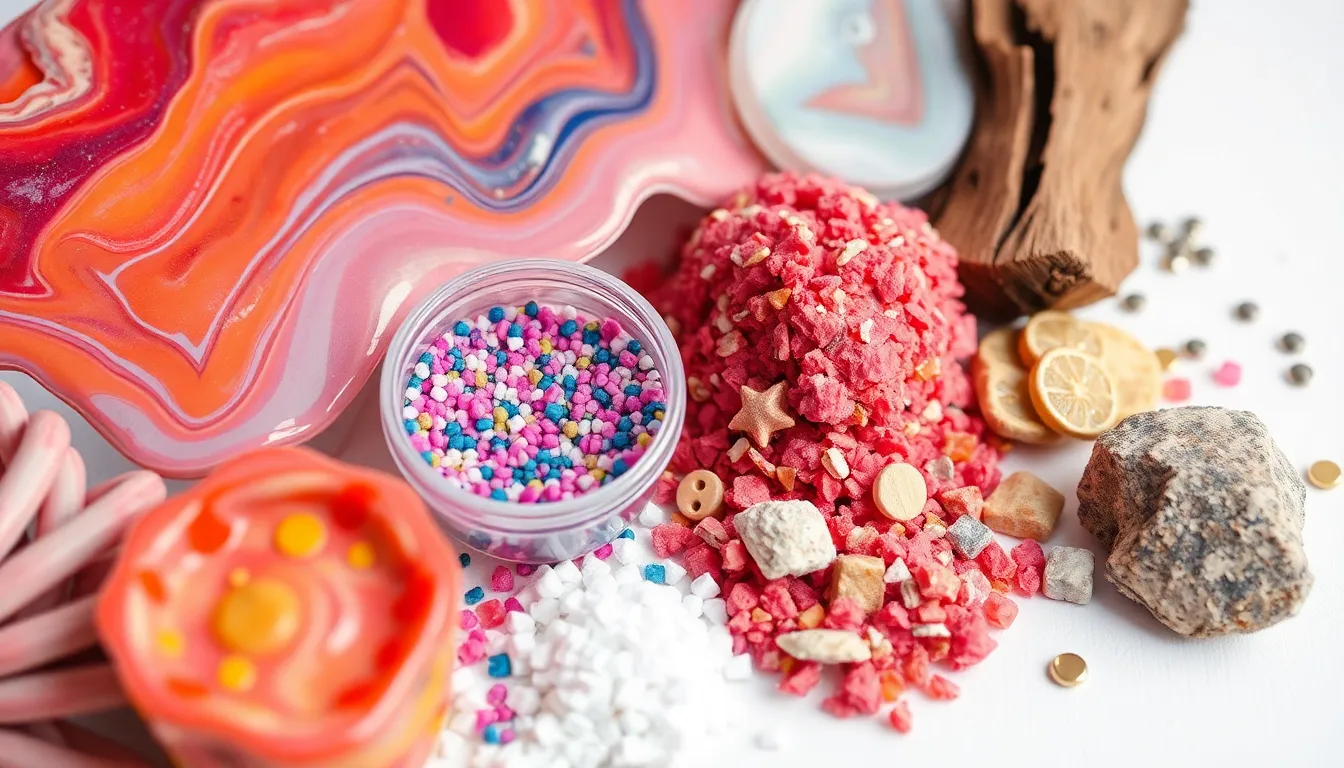The Best Fluffy Pancakes recipe you will fall in love with. Full of tips and tricks to help you make the best pancakes.

Resin Sculpture: Discover the Trend Transforming Modern Art and Home Decor
Resin sculpture is taking the art world by storm, and for good reason. Imagine a medium that combines the durability of plastic with the elegance of glass. It’s like the superhero of the art realm—strong, versatile, and ready to dazzle. Artists are transforming this material into stunning pieces that can elevate any space, from quirky home decor to striking outdoor installations.
What Is Resin Sculpture?
Resin sculpture represents a distinctive form of artistic expression using synthetic resin as the primary medium. Artists utilize this material for its clarity, allowing light to interact dynamically with the surface. Crafting a resin sculpture involves combining resin with various additives to alter its properties, including color and texture.
Various techniques exist for creating resin sculptures, such as pouring, casting, and embedding. Pouring allows for fluid designs, while casting provides detailed shapes and forms. Embedding incorporates objects or materials within the resin, enhancing aesthetic appeal and storytelling.
Artists appreciate resin for its versatility and durability. It withstands outdoor environments, making it suitable for both indoor and outdoor installations. Many sculptures made from resin mimic the appearance of glass or stone, delivering the elegance of high-end materials without the associated fragility.
The appeal of resin sculpture extends to collectors and buyers, drawn to its modern look and unique character. Pieces often feature bright hues or intricate patterns that captivate observers. With advancements in resin technology, artists can push boundaries, experimenting with mixed media and interactive elements.
Sustainability concerns have influenced the resin industry, prompting the development of eco-friendly alternatives. Artists now explore bio-based resins derived from renewable resources, reducing environmental impact. This shift contributes to the ongoing evolution of resin art, ensuring its relevance in the contemporary art scene.
Resin sculpture continues to grow in popularity due to these qualities and innovations, making it a favored choice for many artists.
The Materials Used in Resin Sculpture

Resin sculpture relies on specific materials that enhance its beauty and functionality. Understanding these materials allows artists to maximize their creative potential.
Types of Resin
Epoxy resin stands out as the most common type used in sculptures. Its clarity, durability, and ease of mixing appeal to many artists. Polyester resin also holds popularity due to its quick curing time and cost-effectiveness. Artists often choose polyurethane resin for its flexibility and resistance to impact. Different resins serve unique purposes, allowing creators to achieve distinct aesthetics and functionality.
Additional Components
Mixing additives into resin enhances various qualities. Pigments, for example, provide vibrant color options, improving the visual impact of sculptures. Glitter or metallic flakes can add sparkles and dimension, creating eye-catching effects. Some artists embed organic materials like wood or stone to introduce texture and natural elements. Incorporating these additional components enriches the overall design, ensuring each piece captures attention.
Techniques for Creating Resin Sculptures
Resin sculpture techniques significantly enhance the artistic process. Artists utilize specific methods, including molding and casting, to craft stunning pieces.
Molding and Casting
Molding and casting represent essential methods in creating resin sculptures. A mold captures the desired form, allowing artists to replicate intricate details. Common materials for molds include silicone and urethane, known for their flexibility and durability. Once the mold is prepared, artists mix resin with hardeners and optional pigments to achieve the desired look. Pouring this mixture into the mold initiates the curing process. Curing times vary, influenced by resin types and environmental conditions. After completing the cure, artists demold the sculpture, revealing a detailed piece ready for finishing.
Finishing Touches
Finishing touches elevate the aesthetic appeal of resin sculptures. Artists often sand surfaces to achieve a smooth finish, removing imperfections and enhancing clarity. Coating with varnish or resin further adds gloss and depth. Specific techniques include airbrushing or brush painting, enabling vibrant colors and additional textures. Decorative elements such as metallic powders or inks can also expand visual interest. Lastly, artists assess overall design coherence, ensuring the final piece aligns with their vision and artistic intent. These finishing methods transform a raw sculpture into a polished artwork, ready for display and appreciation.
Care and Maintenance of Resin Sculptures
Proper care and maintenance extend the lifespan of resin sculptures. Regular cleaning helps preserve their clarity and shine. Use a soft, damp cloth to wipe dust and dirt away gently. Avoid abrasive materials that can scratch the surface.
Exposure to direct sunlight can lead to fading over time. Placing sculptures in shaded areas or using UV-protective coatings enhances color retention. Indoor sculptures fare better in stable environments, away from extreme temperatures and humidity.
When storing resin sculptures, temperature plays a critical role. Maintain a cool, dry space to prevent deformation or warping. Stackable storage solutions keep sculptures safe while optimizing space.
It’s vital to handle resin sculptures with care, as they can break under heavy impact. Always lift sculptures by their base to minimize stress on delicate areas. When transporting, wrap them securely to prevent scratches or damage.
For minor repairs, epoxy resin works effectively for fixing small cracks or breaks. Ensure the area is clean before applying any adhesive for stronger bonds. Follow manufacturer guidelines to achieve the best results.
To maintain the visual appeal, consider periodic reapplication of protective finishes. Certain products are designed specifically for resin, forming barriers against environmental factors. Keeping the surface polished enhances its overall appearance and durability.
Resin sculptures benefit from attention and care. Practicing these maintenance techniques ensures they remain vibrant and captivating for years.
Popular Styles and Trends in Resin Sculpture
Resin sculpture showcases various styles that resonate with artists and collectors. Abstract designs remain at the forefront, captivating audiences with fluid lines and dynamic shapes. Nature-inspired themes draw on organic forms, incorporating elements like leaves, flowers, or animals to create visually striking pieces.
Kinetic sculptures stand out by incorporating movement, often requiring wind or manual interaction to animate the artwork. These pieces provide an engaging viewer experience, emphasizing the interplay between structure and motion.
Mixed media integration has gained popularity, allowing artists to combine resin with materials like wood, metal, or glass. This approach adds depth and complexity, enhancing the overall visual impact of the artwork. Artists embrace innovative techniques, such as embedding objects within the resin, which brings additional layers of storytelling to sculptures.
Bright colors and vibrant patterns define contemporary trends in resin sculpture. Artists experiment with bold hues and unique effects, such as translucent layers that interact with light, creating mesmerizing illusions. These striking designs attract collectors seeking pieces that stand out in modern interiors.
Sustainability is shaping current practices, with artists increasingly using eco-friendly bioplastics or recycled materials. This trend reflects a growing awareness of environmental impact, appealing to conscientious consumers. Emerging artists often adopt sustainable methods, merging artistic vision with responsible practices.
Customization continues to thrive in the resin sculpture market, offering collectors personalized pieces tailored to individual preferences. Commissioned works allow for unique designs that hold personal significance, increasing the emotional connection between art and collector.
Overall, the evolution of resin sculpture reveals a rich landscape of styles and trends, showcasing creativity and innovation while responding to contemporary values.
Conclusion
Resin sculpture has firmly established itself as a dynamic and innovative medium in the contemporary art scene. Its unique properties allow artists to push boundaries and explore new creative avenues while appealing to collectors seeking modern aesthetics. As techniques evolve and sustainability becomes increasingly important, the future of resin sculpture looks promising.
With a blend of artistry and technology, resin sculptures continue to captivate audiences and enrich spaces both indoors and outdoors. The versatility of this medium ensures that it will remain a significant part of artistic expression for years to come.
